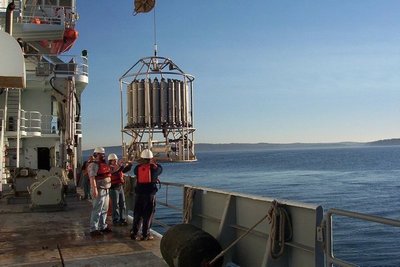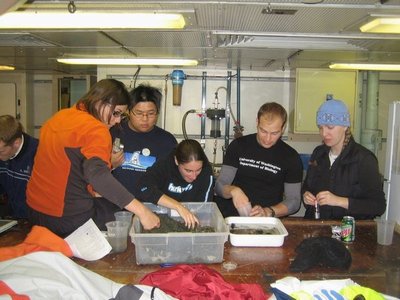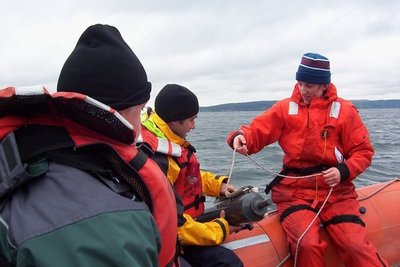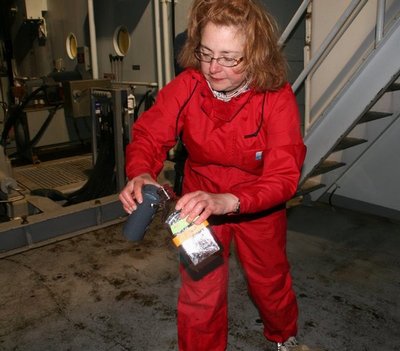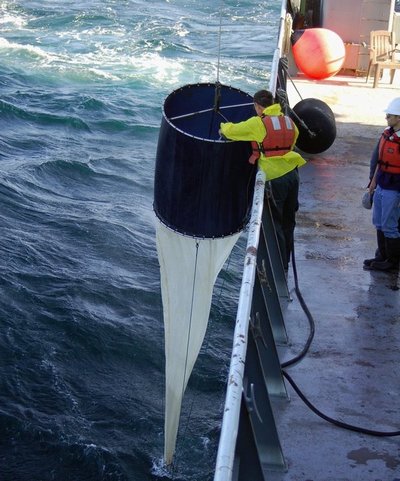November 2, 2006
UW students on the case (and on the ship) researching problems in Puget Sound
While the Seattle Post-Intelligencer was running a six-part series on problems plaguing Puget Sound, UW undergraduates, graduate students and faculty were at work on board the UW’s 274-foot research vessel gathering information needed to help puzzle out some of the sound’s most pressing problems.
Work during expeditions on the Thomas G. Thompson last month included tracking low-oxygen water from the Pacific Ocean through the Strait of Juan de Fuca to Hood Canal, where oxygen-deprived water is a concern when it kills fish. Another expedition sampled other sites in Puget Sound where shellfish beds have had to be closed in past years because of toxic phytoplankton blooms or bacterial outbreaks, a human health concern.
The UW is the only U.S. university that uses a ship as large and sophisticated as the Thompson for student education, according to Rick Keil, an associate professor of oceanography whose undergraduate class developed its own science plans and then executed them during a four-day expedition to learn more about low-oxygen waters of Hood Canal.
“Nobody has done a transect like this during 2006 that extends from the Pacific into Hood Canal and, in fact, nobody I know of has done one in the fall, so the class had a pretty unique opportunity to explore how the ocean connects to Hood Canal,” Keil says.
“We wanted to compare water on the outer coast, in the strait and in Hood Canal looking at phytoplankton, zooplankton, dissolved oxygen and species richness so we might quantify what’s going on,” says Chantell Wetzel, a senior majoring in aquatic and fishery sciences. The 20 students in Ocean 442 were divided into three groups. Wetzel’s group, for example, was concerned with benthic biology, the species found in the sediments.
Another student, Wendy Guo, a senior in oceanography, described work leading up to the expedition saying: “We got possible research topics and a basic outline of ship capabilities and we went to work on our own cruise plans. We had to decide the best ways to get the data we wanted.” Classmates then reviewed each group’s plan and Keil gave advice on what was feasible.
Their initial findings point to a system that isn’t rebooting itself by flushing.
“There didn’t appear to be a lot of deep ocean water going into Hood Canal,” Guo said.
Hood Canal is stagnating again, as it does every year, Keil says. “The coastal upwelling that fueled the inputs of new ocean water into the canal is finished for the year. Because of the way water is mixing in the eastern straits and in Admiralty Inlet, it is preventing any new deep water from getting into Hood Canal.”
“It also looks as if there is a small bloom of phytoplankton in Hood Canal that is growing in the low-oxygen water that was upwelled and killed the fish a month or so ago. Since phytoplankton aren’t sensitive to low oxygen, but are limited by nutrients, the upwelling that killed the fish was a boon for the phytoplankton. They are growing, assimilating nutrients, dying and sinking in the canal faster than the water is being flushed out. What this means is that they are acting as a nutrient-concentrating mechanism, which means that the canal is keeping its nutrient load and, thus, exacerbating the problem.”
Check the class Web site at http://courses.washington.edu/pugetoce/ for photos and video from the expedition and at the end of the quarter for the groups’ papers about their findings.
The situation in Hood Canal can cause deadly conditions for fish while other spots around the sound have posed dangers for humans in recent years. Algal blooms in Puget Sound are increasingly producing domoic acid, which can sicken and — in high enough doses — kill humans, other mammals and birds when they eat fish or shellfish contaminated with the toxin.
Since the 1991 discovery of domoic acid along the Washington coast, samples of shellfish have regularly been collected and analyzed by the Washington Department of Fish and Wildlife, tribal nations and Washington Department of Health. When levels are too high, beaches are closed to harvesting. The closure of commercial shellfish beds near Port Townsend in fall 2003 was the first domoic acid-based closure on Puget Sound
Understanding these toxic blooms is the focus of the Pacific Northwest Center for Human Health and Ocean Sciences, a national research center based at the UW, and of another expedition last month on the Thompson.
Human-health concerns did not prompt closure of any areas in Puget Sound this year, giving researchers a chance to look at the characteristics of water at sites where there have previously been problems, says Gabrielle Rocap, an assistant professor of oceanography and chief scientist for the cruise Oct. 12-15. The researchers did extensive sampling, she says, visiting sites in the main basin of Puget Sound, Port Madison, around Vashon Island, Hood Canal, Strait of Juan de Fuca, Discovery Bay, Whidbey basin and Penn Cove.
According to preliminary analysis done on the ship during the expedition, the diatom Pseudo-nitzschia, which is harmless unless it is producing domoic acid at dangerous levels, was found at highest concentrations in water samples from the Whidbey Basin according to Micaela Parker, a research scientist with oceanography. It was found in much lower concentrations closer to the shore in that area.
Where the diatoms are concentrated and where they are carried are among the things researchers are trying to discover as they investigate the environmental conditions that trigger blooms of harmful algae. How the blooms affect public health, for instance determining what populations are at greatest risk, was another area of concern for the researchers who were on board the Thompson.
During the expedition, some time each day was devoted to working meetings between the oceanographers and public health researchers to share research discoveries and discuss plans for a new course in the field of oceans and human health. The Pacific Northwest Center for Human Health and Ocean Sciences, co-directed by Elaine Faustman, professor of environmental and occupational health sciences, and Ginger Armbrust, professor of oceanography, is in the midst of a seminar series this fall (see details at http://depts.washington.edu/pnwh2o/news.html) and hopes to offer a course in the fall of 2007.
“Every field has its jargon, its way of communicating concepts,” Parker said. “We’re trying to learn to communicate oceanography in ways that public health participants can understand and they are trying to do the same for us.”
The human health expedition included two undergraduates who worked on projects last summer with center researchers.
“A unique attribute of our educational programs is having the resources to use the Thompson in ways that provide both hands-on learning experiences for our students and at the same time enables research that contributes to addressing complex problems of importance to our region,” says Russ McDuff, director of the School of Oceanography.
In addition to the longer cruises last month, the school also offered three shorter outings using the Thompson for undergraduate classes led by lecturer Richard Strickland, professor Chuck Nittrouer and aquatic and fishery science’s Thomas Pool.
Tag(s): oceanography • Puget Sound • Rick Keil • RV Thomas G. Thompson • School of Oceanography
